
Inaccurate: More people have died from COVID-19 in the U.S. than any other country in the world. When data is normalized to account for differences in population size across countries, the number of deaths in the U.S. remains higher than that of Europe. The claim that COVID-19 is less deadly in the U.S. than in Europe is false.

FULL CLAIM: The U.S. has “a better handle on [COVID-19] than Europe”; “the disease is less deadly here than it is in most of Europe, based on case fatality data”; “coronavirus cases are now exploding in Europe at rates far higher than the U.S.,” and, “the share of positive test results is higher in Europe, as is the case fatality rate”
REVIEW
This article, published by Issues and Insights at the end of October 2020, claims that “coronavirus cases are now exploding in Europe at rates far higher than the U.S.,” and, “the share of positive test results is higher in Europe, as is the case fatality rate.” Based on these claims, the article concludes that “the U.S. [is] having a better handle on it than Europe.” The article has received more than 29,000 interactions on Facebook, according to social media analytics tool CrowdTangle.
To support its claims, the article relies on five graphs from the Our World in Data coronavirus database, which visualizes daily statistics on the COVID-19 pandemic. One of the most prominent sources used by Our World in Data is the European Centre for Disease Prevention and Control:
“The European CDC publishes daily statistics on the COVID-19 pandemic. Not just for Europe, but for the entire world. We rely on the ECDC as they collect and harmonize data from around the world which allows us to compare what is happening in different countries. The European CDC data provides a global perspective on the evolving pandemic.”
Specifically, the graphs used in the Issues and Insights article compare COVID-19 data for the U.S. with that for several European countries, namely France, Italy, Switzerland, and the United Kingdom. To evaluate the accuracy of the article’s claims, Health Feedback examined statistics from the Our World in Data database, as well as statistics published in other databases, such as the World Health Organization’s COVID-19 Dashboard and the Coronavirus Resource Center by Johns Hopkins University.
Over the course of the pandemic, the U.S. has the highest number of total COVID-19 infections worldwide
The article includes a graph showing the number of daily new COVID-19 cases between 24 August and 27 October 2020 to support the claim, “coronavirus cases are now exploding in Europe at rates far higher than the U.S.,” and, “the share of positive test results is higher in Europe, as is the case fatality rate.”
During that time period, the daily number of new confirmed COVID-19 cases per million people in France, Italy, Switzerland, the United Kingdom, and Europe in general, overtook that of the U.S., supporting the article’s statements (see Figure 1 below). The increase in the number of daily COVID-19 cases started in September 2020, due to the second wave of infections in Europe. This observation was also reported by several mainstream media outlets, including the Washington Post and CNBC, contrary to the article’s headline and statements that this data is intentionally being hidden by the press.
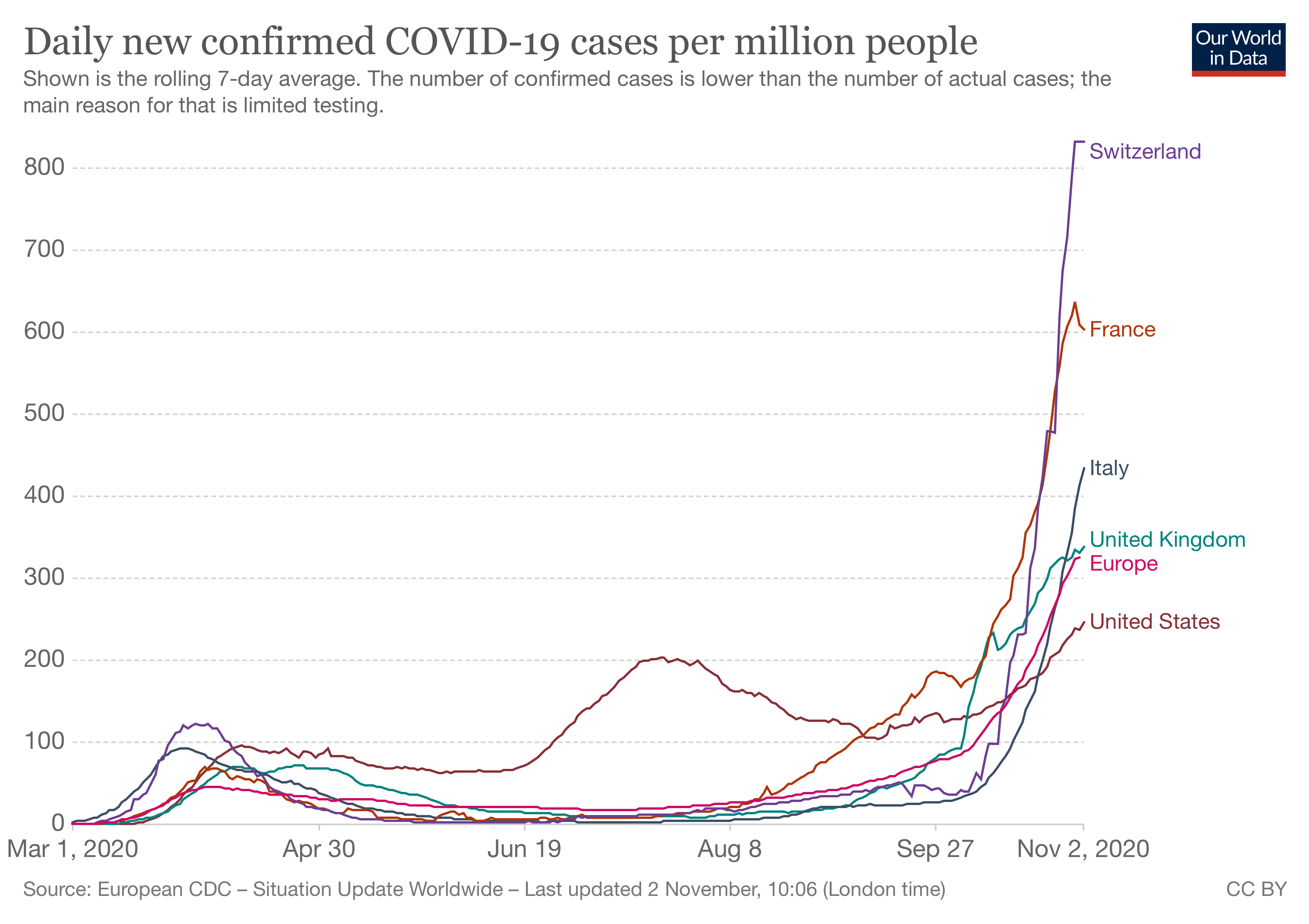
Figure 1. The daily number of new confirmed COVID-19 cases per million people for the U.S., France, Italy, Switzerland, the U.K., and all of Europe (rolling 7-day average), between 1 March and 2 November 2020. Data and graph from Our World in Data.
However, the article’s focus on the window of time between late August and October 2020 could mislead readers as it ignores data on the daily number of new COVID-19 cases over the entire pandemic. When considering the full time period of the pandemic, Europe in general saw fewer new daily cases than the U.S. This can be seen in Figure 1, which shows data from March to November 2020, where daily new COVID-19 cases in the U.S. remained higher than those of European countries, as well as all of Europe, for the majority of the pandemic period. It is important to note that the European continent contains a population of more than 747 million people, which is more than twice that of the U.S., which has a population of approximately 330 million.
Therefore, the assertion that “the U.S. [has] a better handle on it than Europe” made in the article cannot be supported when considering the daily number of new COVID-19 cases for the entire timescale of the pandemic.
Another metric that can be used to evaluate a country’s performance in controlling the spread of COVID-19 is the total number of infections, which has been recorded throughout the entire pandemic. The U.S. currently reports the highest number of total infections in the world, according to multiple databases: Our World in Data (see Figure 2 below), the World Health Organization, the Coronavirus Resource Center maintained by Johns Hopkins University, and Worldometers.
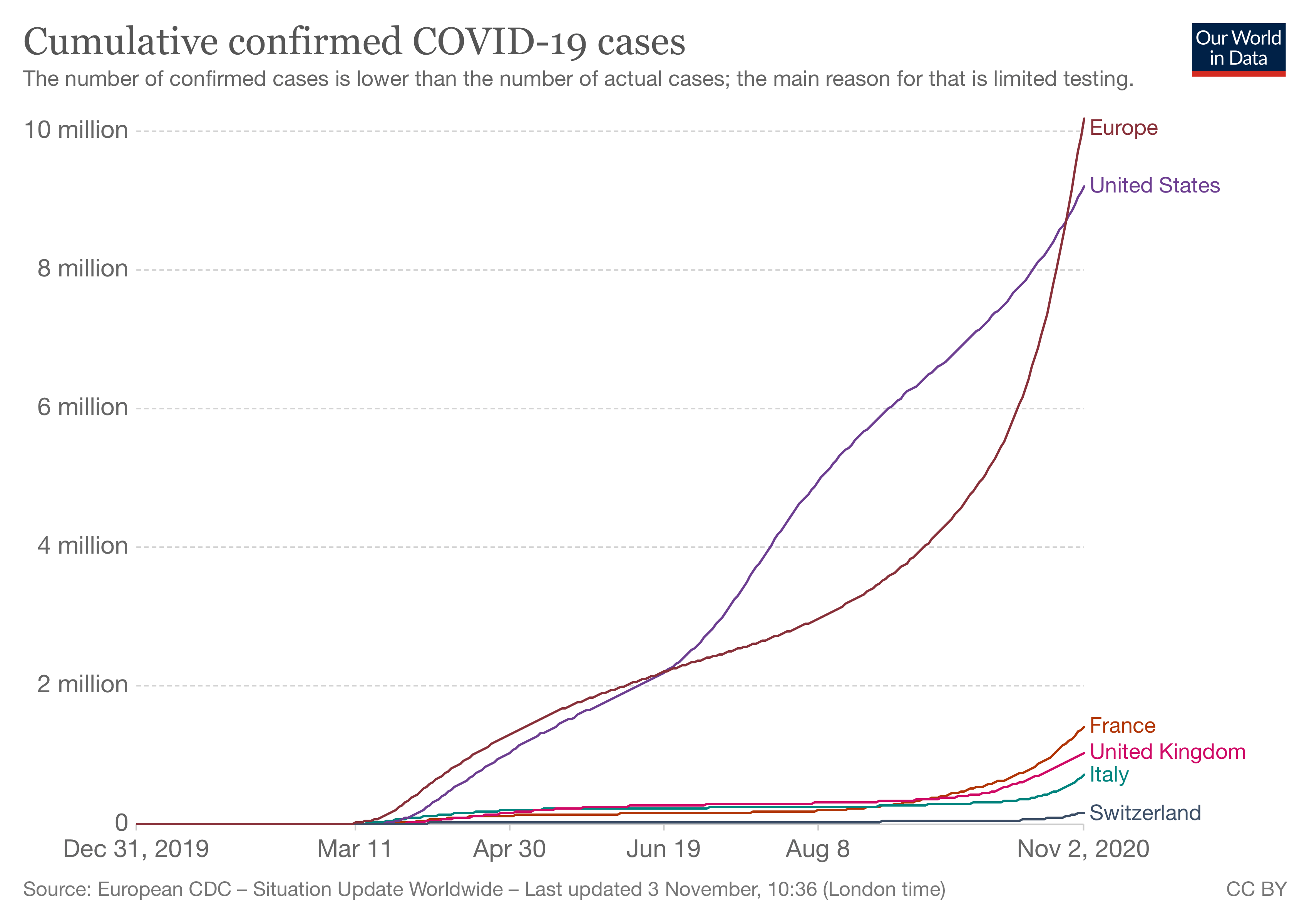
Figure 2. The cumulative or total number of confirmed COVID-19 cases for the U.S., France, Italy, Switzerland, and the U.K. between 31 December 2019 and 2 November 2020. Data and graph from Our World in Data.
The positivity rate (also called percent positive) tells us the proportion of COVID-19 tests that returned a positive result among all tests. Unlike the total number of infections, the positivity rate is a proportion of the total number of tests conducted. Therefore, positivity rate is not influenced by differences in testing rates across countries, although positivity rate can be influenced by testing policies, for instance if testing is mainly focused on people who already show symptoms. According to the Johns Hopkins School of Public Health:
“The percent positive is a critical measure because it gives us an indication how widespread infection is in the area where the testing is occurring—and whether levels of testing are keeping up with levels of disease transmission.”
The article includes a graph of the share of daily COVID-19 tests that are positive, but again only shows data from late August to October 2020. However, when evaluating this metric over the entire period of the pandemic, France, Italy, Switzerland, and the U.K. show lower positivity rates than the U.S. for most of the pandemic from April to September 2020 (see Figure 3 below). When considering the entire timeframe of the pandemic, these data also contrast with the article’s claim that the U.S. has a better handle on COVID-19 than Europe.
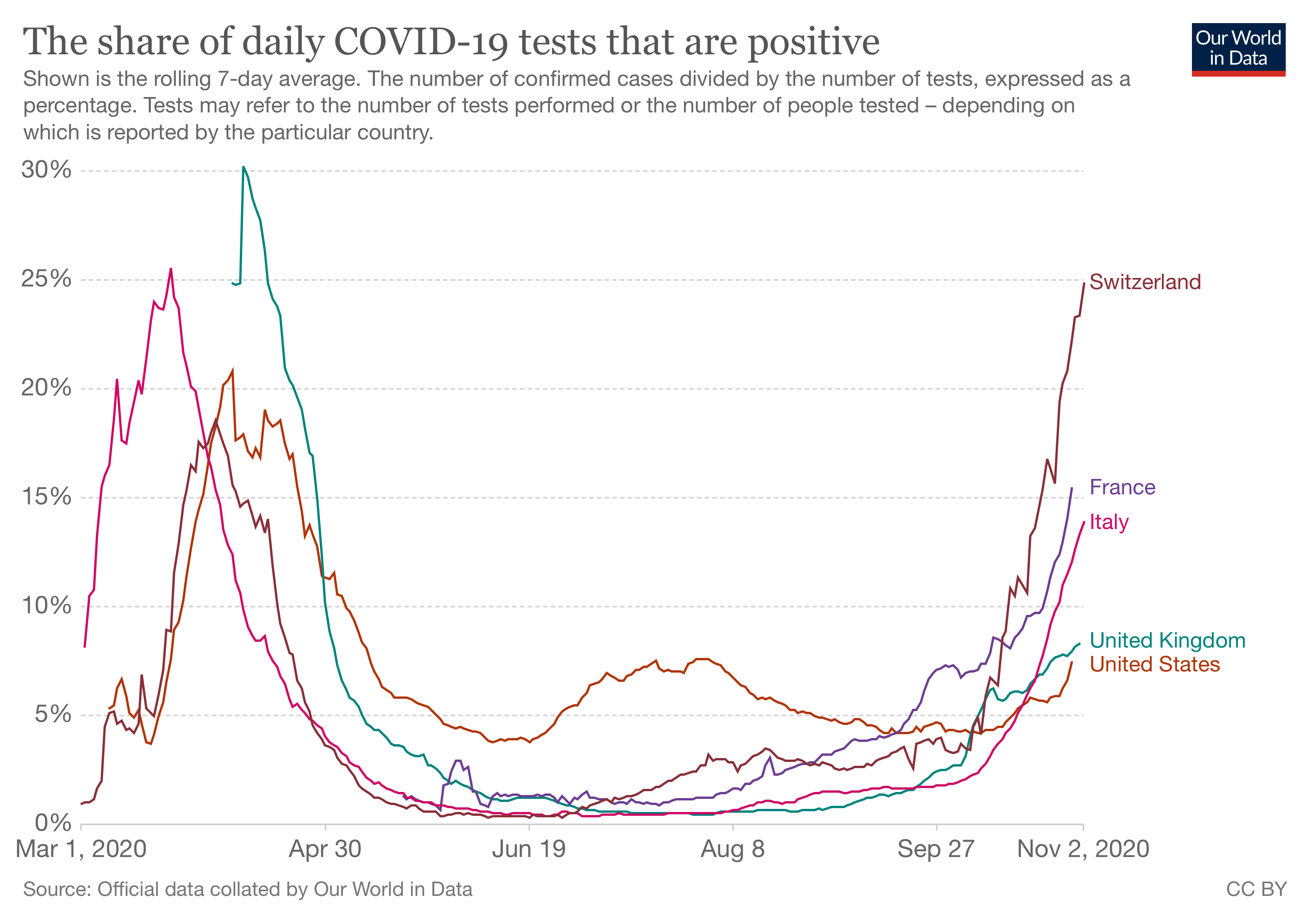
Figure 3. The daily positivity rate, or the proportion of tests that return a positive result, for the U.S., France, Italy, Switzerland, and the U.K. (rolling 7-day average) between 1 March and 2 November 2020. Data and graph from Our World in Data.
Over the course of the pandemic, the U.S. has the highest number of total COVID-19 deaths worldwide
The article also claims, “the disease is less deadly [in the U.S.] than it is in most of Europe, based on case fatality data.” The case fatality ratio (CFR) represents the proportion of deaths among confirmed COVID-19 cases. Over the course of the pandemic, the U.S. has a lower CFR compared to France, Italy, Switzerland, and the U.K., with the exception of Switzerland (see Figure 4 below).
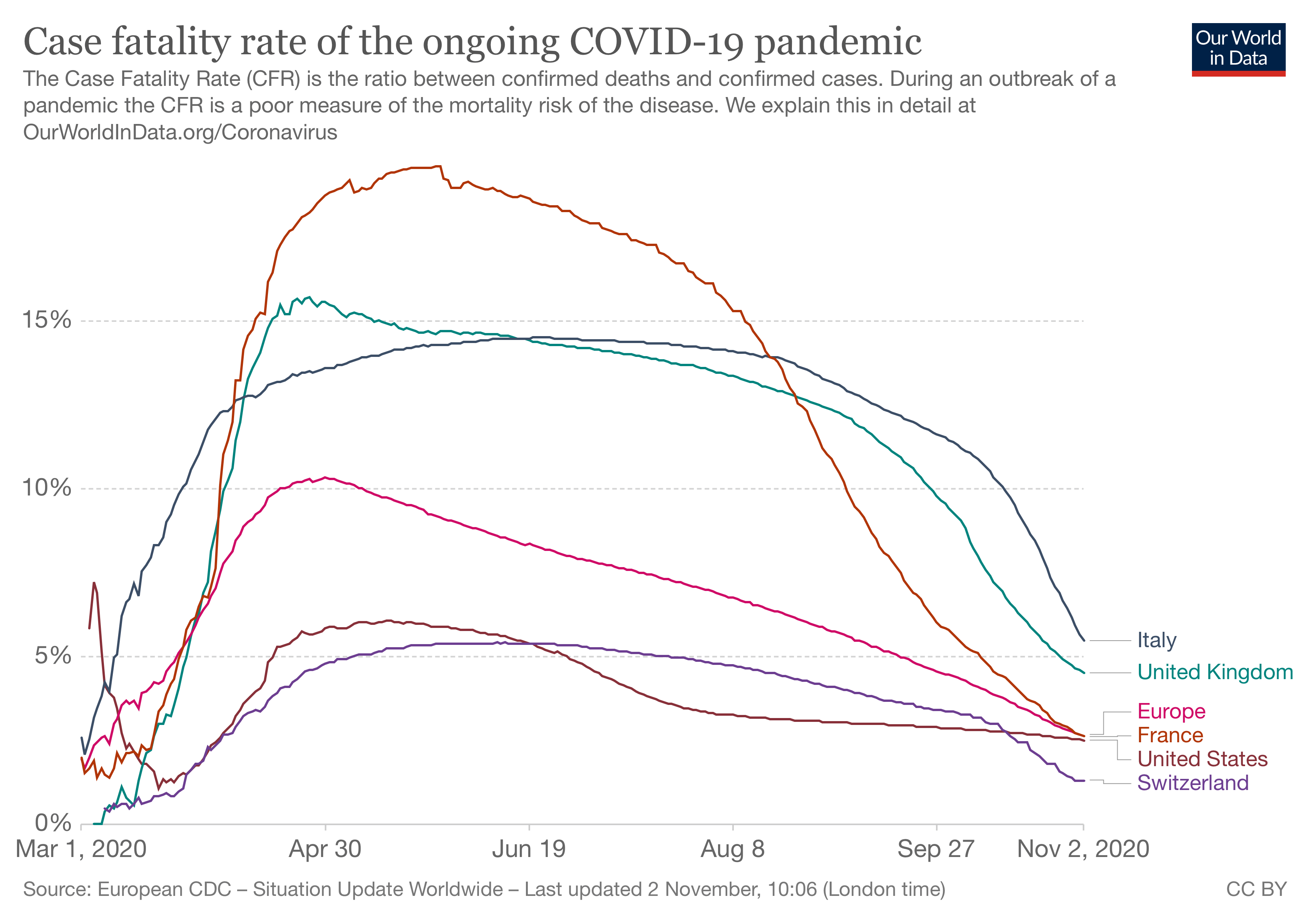
Figure 4. The case-fatality rate of the COVID-19 pandemic for the U.S., France, Italy, Switzerland, the U.K., and Europe between 1 March and 2 November 2020. Data and graph from Our World in Data.
However, the CFR of COVID-19 is not a reliable method for estimating mortality risk from the disease, as it can be influenced by unrelated factors, such as the availability of testing. Testing influences the number of confirmed cases, and subsequently the CFR. Another important factor is timely and accurate mortality reporting, which is important for counting deaths accurately. Our World in Data explains in detail:
“If the number of total cases is higher than the number of confirmed cases, then the ratio between deaths and total cases is smaller than the ratio between deaths and confirmed cases. This of course assumes that there is not also significant undercounting in the number of deaths; it’s plausible that some deaths are missed or go unreported, but we’d expect the magnitude of undercounting to be less than for cases.
Importantly, this means that the number of tests carried out affects the CFR – you can only confirm a case by testing a patient. So when we compare the CFR between different countries, the differences do not only reflect rates of mortality, but also differences in the scale of testing efforts.”
Given these limitations, the graph used in the article and Figure 4 above state, “During an outbreak of a pandemic the CFR is a poor measure of the mortality risk of the disease.” Therefore, the article’s claim that COVID-19 is less deadly in the U.S. than Europe based on the CFR is misleading, as CFR cannot accurately measure mortality risk from a disease.
Furthermore, by looking at the actual death toll, the claim that COVID-19 is less deadly in the U.S. than in European countries is false, even after accounting for differences in population size. By comparing the number of daily new confirmed COVID-19 deaths reported by each country, it is clear that the U.S. has had the highest number of new deaths each day for most of the pandemic thus far, even compared to Italy, one of the hardest-hit European countries, as shown in Figures 5 and 6. Figure 5 shows the daily number of new confirmed COVID-19 deaths, while Figure 6 reports the same statistic per million people, which accounts for differences in population size between countries.
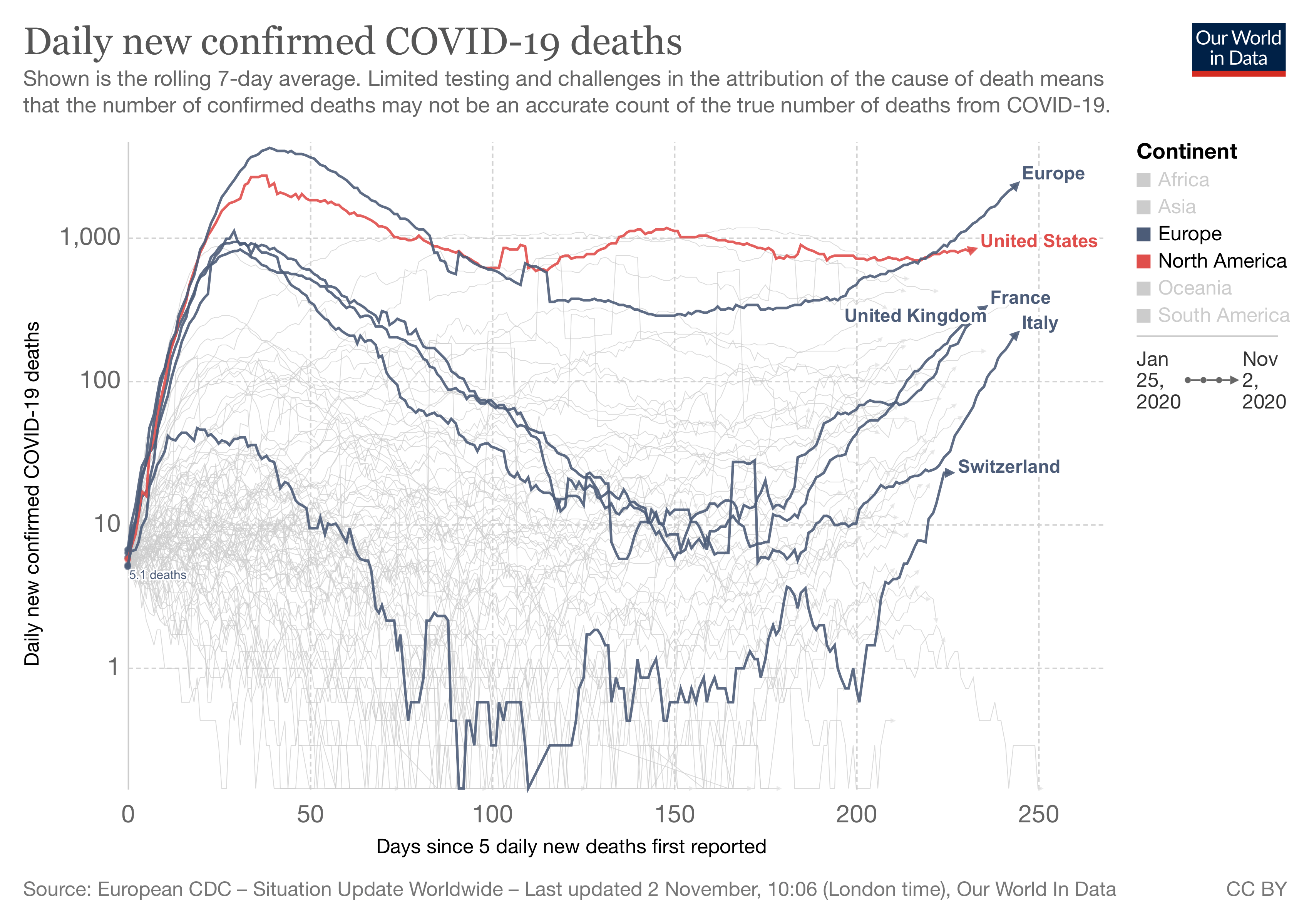
Figure 5. The daily number of new confirmed COVID-19 deaths (rolling 7-day average), shown for the U.S., France, Italy, Switzerland, the U.K., and all of Europe, between 25 January and 2 November 2020. Data and graph by Our World in Data.
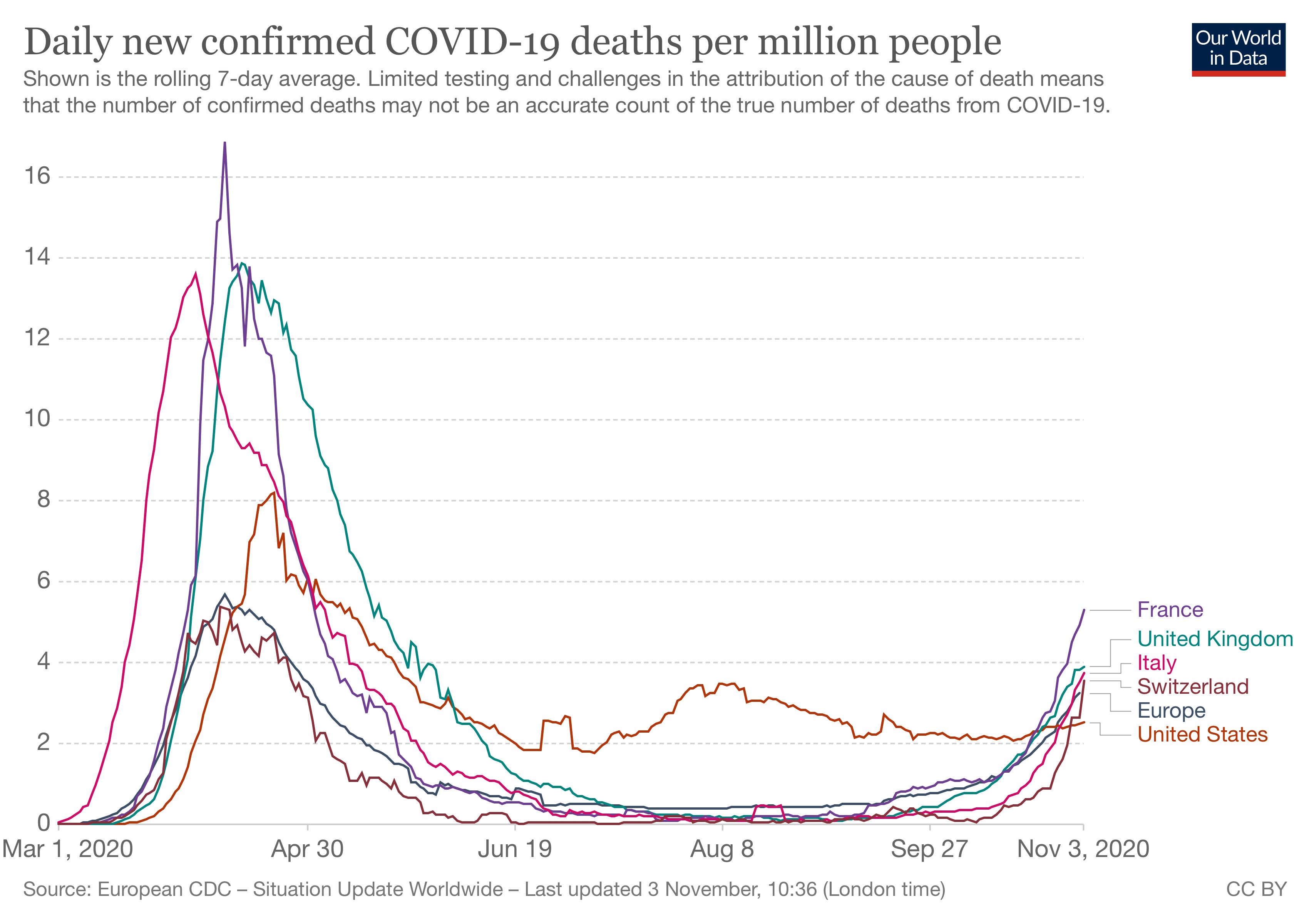
Figure 6. The daily number of new confirmed COVID-19 deaths per million people (rolling 7-day average), shown for the U.S., France, Italy, Switzerland, the U.K., and all of Europe, between 1 March and 2 November 2020. Data and graph by Our World in Data.
In addition, the U.S. has the highest total number of COVID-19 deaths among all countries worldwide, according to the World Health Organization, the Coronavirus Resource Center maintained by Johns Hopkins University, and Worldometers. When accounting for differences in population size, the U.S. has more COVID-19 deaths per million people than Europe. Some European countries, like the U.K. and Italy, have slightly lower deaths per million people than the U.S. (see Figure 7). Based on this data, the claim that COVID-19 is less deadly in the U.S. than in Europe is inaccurate.
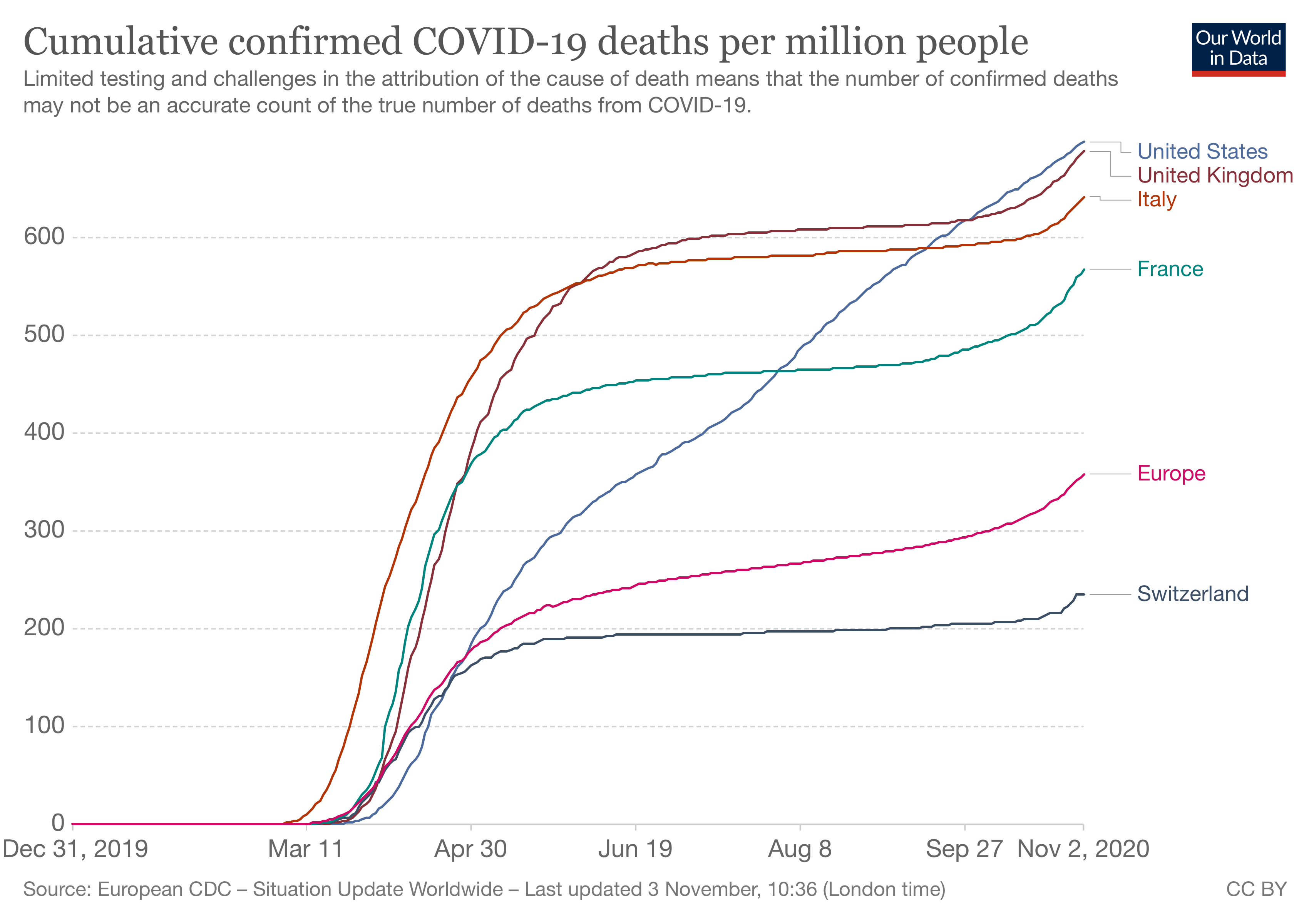
Figure 7. The cumulative or total number of COVID-19 deaths per million people, shown for the U.S., France, Italy, Switzerland, the U.K., and all of Europe, between 31 December 2019 and 2 November 2020. Data and graph from Our World in Data.
Conclusion
In summary, the article uses a subset of data from the COVID-19 pandemic to support the claim that COVID-19 is less deadly and being handled more effectively in the U.S. than in Europe. Since September 2020, European countries have experienced a rise in the daily number of new COVID-19 cases, currently outpacing the U.S. However, data from the entire timeframe of the COVID-19 pandemic demonstrates that the U.S. has the highest total number of infections and deaths than any other country in the world. And when differences in population sizes are accounted for, the U.S. has more COVID-19 deaths per million people than Europe.


